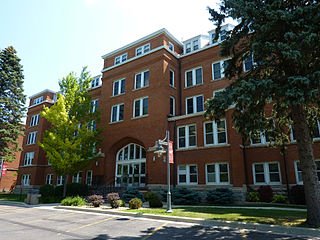
Bethany Lutheran College (BLC) is a private Christian liberal arts college in Mankato, Minnesota. Founded in 1927, BLC is operated by the Evangelical Lutheran Synod. The campus overlooks the Minnesota River valley in a community of 53,000.
The Synod of the Norwegian Evangelical Lutheran Church in America, commonly called the Norwegian Synod, was founded in 1853. It included churches in Illinois, Iowa, Minnesota and Wisconsin.

The American Lutheran Church was a Christian Protestant denomination in the United States and Canada that existed from 1960 to 1987. Its headquarters were in Minneapolis, Minnesota. Upon its formation in 1960, the ALC designated Augsburg Publishing House, also located in Minneapolis, as the church publisher. The Lutheran Standard was the official magazine of the ALC.
1517 Media, formerly Augsburg Fortress, is the official publishing house of the Evangelical Lutheran Church in America (ELCA), also publishing for the Evangelical Lutheran Church in Canada (ELCIC) as Augsburg Fortress Canada. Headquartered on South Fifth Street in Minneapolis, Minnesota, in the former headquarters of the American Lutheran Church, Augsburg Fortress publishes Living Lutheran, the Lutheran Book of Worship (1978), the Lutheran Study Bible, and Evangelical Lutheran Worship (2006), as well as a range of academic, reference and educational books. Tim Blevins has served as the CEO of 1517 Media since August, 2018. Beth Lewis served as the CEO of Augsburg Fortress since September 3, 2002.

The Evangelical Lutheran Synodical Conference of North America, often known as the Synodical Conference, was an association of Lutheran synods that professed a complete adherence to the Lutheran Confessions and doctrinal unity with each other. Founded in 1872, its membership fluctuated as various synods joined and left it. Due to doctrinal disagreements with the Lutheran Church–Missouri Synod (LCMS), the Evangelical Lutheran Synod (ELS) and the Wisconsin Evangelical Lutheran Synod (WELS) left the conference in 1963 It was dissolved in 1967 and the other remaining member, the Synod of Evangelical Lutheran Churches, merged into the LCMS in 1971.

Hillcrest Lutheran Academy is a private Christian school in Fergus Falls, Minnesota. Established in 1916, Hillcrest is affiliated with the Church of the Lutheran Brethren of America.

Luther Seminary is a seminary of the Evangelical Lutheran Church in America (ELCA) in Saint Paul, Minnesota. It is the largest seminary of the ELCA. It also accepts and educates students of 41 other denominations and traditions. It is accredited by the Higher Learning Commission and the Association of Theological Schools. It also has theological accreditation through the ELCA as well as the United Methodist Church.
The Evangelical Lutheran Church (ELC) was a Lutheran denomination that existed from 1917, when it was founded as the Norwegian Lutheran Church of America (NLCA), until 1960, when it joined two other church bodies to form the second American Lutheran Church.

The United Norwegian Lutheran Church of America (UNLC) was the result of the union in 1890 of the Norwegian Augustana Synod, the Conference of the Norwegian-Danish Evangelical Lutheran Church of America (1870), and the Anti-Missourian Brotherhood (1887). Some sources give the church's name as "in America" instead of "of America",

Ulrik Vilhelm Koren was a Norwegian-American author, theologian and church leader. A pioneer Lutheran minister, he played a significant role in the development of the spiritual and intellectual development of Norwegians in America. Ulrik Vilhelm Koren has been called the "patriarch of Norwegian American Lutherans."
The Hauge Synod, was the name of a Norwegian Lutheran church body in the United States in the late 19th century and early 20th century.

The Norwegian Lutheran Church in the United States is a general term to describe the Lutheran church tradition developed within the United States by immigrants from Norway.

The Haugean movement or Haugeanism was a Pietistic state church reform movement intended to bring new life and vitality into the Church of Norway which had been often characterized by formalism and lethargy. The movement emphasized personal diligence, enterprise and frugality.

Johan Arnd Aasgaard was an American Lutheran church leader.

August Weenaas (1835–1924) was a Norwegian American Lutheran minister and educator. August Weenaas was the founding President of Augsburg University.

Hans Gerhard Stub was an American Lutheran theologian and church leader. He served as Bishop of the Norwegian Lutheran Church in America.
The Evangelical Lutheran Joint Synod of Ohio and Other States, commonly known as the Joint Synod of Ohio or the Ohio Synod, was a German-language Lutheran denomination whose congregations were originally located primarily in the U.S. state of Ohio, later expanding to most parts of the United States. The synod was formed on September 14, 1818, and adopted the name Evangelical Lutheran Joint Synod of Ohio and Other States by about 1850. It used that name or slight variants until it merged with the Iowa Synod and the Buffalo Synod in 1930 to form the first American Lutheran Church (ALC), 1930-1960.
Thorstein Himle was a Norwegian-born American missionary affiliated with the American Lutheran Hauge Synod Mission to China.
English Evangelical Lutheran Synod of the Northwest was formed in September 1891 as a synod within the General Council of the Evangelical Lutheran Church in North America. Churches within the synod used English as their primary language to connect with younger generations of English-speakers. The Northwest Synod covered a geographical territory from Milwaukee to Seattle, although few Lutherans lived between Minnesota and Washington. On September 25, 1901 the Northwest Synod split to create the Pacific Synod on the Pacific coast. The Northwest Synod was divided into three conferences: Central Conference, Western Conference, and Wisconsin Conference.
The American Lutheran Church (ALC) was formed in 1930 from the merger of the three conservative Lutheran synods of German-American origin: The Evangelical Lutheran Synod of Iowa and Other States, established in 1854; the Lutheran Synod of Buffalo, established in 1845; and the Evangelical Lutheran Joint Synod of Ohio and Other States, established in 1818 from the Ministerium of Pennsylvania. The headquarters of the ALC were in Columbus, Ohio, which had been the headquarters of the Joint Synod of Ohio, the largest of the three synods.







